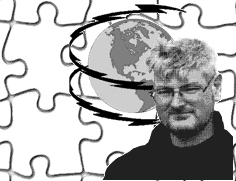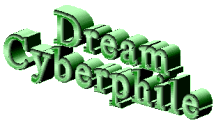In the past year the focus of information in the cyberphile has been on getting
connected to the Internet and exploring the tools of this new communication revolution.
We've slowly shifted the emphasis from the technical aspects of web browsing, e-mail and
listserv's to specific examples of their use as in the empirical research of Content
Analysis and the ASD Homepage. This shift from the physical structure of the Internet to
the psychological ecology of Cyberspace now continues in a two part series with one of the
most prominent and more controversial areas of dream related cyberspace, dream sharing and
dream work.
Because of the dense interconnectivity of the Net, the dozens of online dream networks
are able to each serve multiple functions including news gathering and dissemination,
study groups, resource listings, literature archiving, message boards for discussions and
other functions. Still, dream work continues to be a major thread and this issue column
will cover the early developments, message boards and e-mail dream sharing. The next issue
will focus on the explosion of the dream sharing sites on the World Wide Web and other new
forums.
Caution: ASD does not endorse nor support any of these sites or
practices. The purpose of this article is informational and educational.
Pre-(Net)Historic Dream Communications
Long distance communications have been available for quite awhile and have been used by
dream concerned individuals in various ways. Phone calls to fellow researchers, 900 dream
interpretation numbers, calls to friends and family about "The nightmare I just
had!" and pre-cognitive dream fears are all well known (1), as
well as talk shows on Radio and Televison.
With the advent of modems, devices able to connect computers via telephone lines, there
arose regional Bulletin Board services (BBS). Now people could leave messages and
communicate with others who weren't directly connected to the Bulletin Board at that
particular moment. John Herbert, for example, used this system to conduct a study on the
difference between dream groups that met only by posts to bulletin boards, and those
meeting Face-to-Face (2). But to connect to a BBS you have to call that
phone number directly. If you don't live in the same Area Code, it can get very expensive.
And so one BBS would be somewhat isolated from other BBS's.
When USENET became popular among the USA University crowd in the late 1980's, the idea
of the Regional Bulletin Board was expanded nationally (and in some cases,
internationally) and the discussion of dreams could be found in various Usenet Newsgroup
topic boards. Usenet was organized like a real bulletin board, where one could post a note
and others could read and post replies. Group discussions may them develop over time.
Because of the popularity of BBS's, the Usenet bulletin boards were called
"Newsgroups". By the 1990's all but the most wild of the Newsgroups were
accessible via the Internet, and it was clear that dreams needed their own Newsgroup.
"alt.dreams" was formed (3).
The Newsgroup alt.dreams was originally suggested by Jack Campin as a way to study
contemporary culture. He wanted a snapshot of dreams in the late 20th Century much in the
same way that The Third Reich of Dreams (4) gives a snapshot of the
society in Nazi Germany. But it was soon apparent that the real appeal of alt.dreams was
to share dreams and discussions about their significance and meaning.
Although alt.dreams provided a global gathering spot and spawned other related
newsgroups like alt.dreams.lucid and alt.dreams.castaneda, the un-moderated venue lacked
something essential for those used to face-to-face dream sharing. Individuals that did
want more formed smaller private e-mail groups away from the alt.dreams newsgroup.
Electric Dreams and other Dream Communities
One of these groups distributed a collection of the dreams and comments between the
subscribers and then published the comments and replies in a weekly format. When I found
the community in the fall of 1994 they had grown to about 60 members and the dreams and
comments were shared in a bi-monthly E-zine, (an electronically distributed magazine via
E-mail) which they called Electric Dreams. Interest in this format grew and Electric
Dreams grew from 60 to 500 subscribers in the following year and added news, articles and
experimental dream events, but remained primarily focused on dream sharing in cyberspace.
Concerns about this free speech forum now include a). the potential abuse of interpretive
authority (anyone can comment and pretend they are someone they are not and some feel that
*any* comment is abusive), b). lack of support for dreamers who submit dreams (what if a
dream interpretation unlocks psychological instability?) and c). context or set &
setting confusion (5) (What if someone thinks this is psychotherapy, what
if children joined a group with adults? ).
Another of the problems faced by the Electric Dreams community was the two week delay
in the dream being presented and the return comments. A solution was found when I met John
Herbert and participated in his ALL SeniorNet Dream Bulletin Board. John Herbert's groups
used a variation of some of the Ullman/Zimmerman techniques (10), which
he had worked out on the WELL and ALL. A dream was selected, the group asked
non-interpretive questions, then each person took the dream as their own. During the
process, the dreamer could respond or reply as he or she chose.
The process was modified for e-mail and the first Electric Dreams Dream Circles (6) were created. A dream was passed around in round-robin style from one
e-mail address with questions and replies added by each participant. The ED Dream Circle
was great for sharing dreams, but an administrative nightmare. Jay Vinton suggested we use
a Mail List style approach and the problems seemed to disappear. In a Mail List approach,
all the members send all comments to everyone in the group, even if the comment is
directed to just one individual. This process creates a feeling of group identity and
cohesion.
These new mail list dream groups, the Dream Wheels (No connection with the Ramsay
Raymond Dreamwheel), have evolved in several new creative directions. Generally the
process has been refined and newer sharing and distribution methods have improved (For
more on the technical aspects of Mail Lists, see the Dream Cyberphile pg 26 in the ASD
newsletter 1996 13.1, 26-27.). However, while the technical & methodological
procedures have developed quickly, the resolution of concerns about the safety and
appropriateness of dream sharing online seems to be taking a little more time.
Cyber-Dream Sharing Goes To School and Gets International Attention
Both Jayne Gackenbach and I felt that combining education with the experiential groups
represented an advance over just offering experimental groups. Several projects followed.
Jayne developed a program with Grant MacEwan which now includes e-mail classes and
bulletin board dream sharing.(8) . When I expanded the DreamGate classes
to include the community beyond Electric Dreams subscribers, we incorporated many of the
safety features that Jayne created and implemented in her classes including the
post-session questionnaires and the pre-session clarifications about the context and rules
of group.(9)
When the Dream Cyberworld Project for the ASD XIII conference was proposed, the ASD
executive board foresightedly accepted and supported the project. The only concern was
that dream sharing via computers at the conference might be confused as promotion or
endorsement when in fact we were all still wondering as a group just exactly what it
really was. The Conference XIII programs thus provided no online dream sharing, but did
provide plenty of examples and samples, giving interested individuals a chance to see the
spectrum of possibilities .
During the Berkeley Conference XIII, Sarah Richard's brought together in a panel the
many of the more active of individuals involved in online dream sharing, including Jayne
Gackenback, Jeremy Taylor, John Herbert and myself. Fred Olsen and Linton Hutchinson also
participated in sharing their collective experiences. Not one of these people reported any
problems with online dream sharing in any of the groups or sessions. There were some who
were confused about the procedures at times, and some who didn't participate who didn't
like the *idea* of what was happening, but no reports of unhappy participants or incidents
requiring crisis intervention.
The idea of dream sharing on the Net continues to bring to peoples' minds a myriad of
possible disasters. Why haven't these disasters shown up?
Herbert's study suggests that online dream sharing provides more insight than
face-to-face dream sharing. His results were not statistically significant but reveal an
observation that in the cooler, non-confrontive atmosphere of writing e-mail at one's home
computer, the responses and questions to and from the dreamer are more reflective and less
emotional. This also points to a weakness in e-mail dream sharing scheme for those who
like more emotional interplay. It appears then, that while dream groups online may not yet
be appropriate for many psychotherapy, they do provide a safe and anonymous venue for
adults to meaningfully explore meaning and value.
As these dream sharing groups evolve and more studies are done, we will have a better
picture of the scope, range and relevancy of e-mail and bulletin board style dream
sharing.
The rules keep changing, but here is the most commonly used reference manual online:
If you find a better reference manual, or have other essential cyber-dreaming
information, be sure to tell the rest of us by leaving a post on the ASD Online Bulletin Board
note 1/1/99: ASD now has a Research Request section on the site with links to
Electronic referencing APA, Chicago Style, MLA and others.
 Return to ASD HOMEPAGE
Return to ASD HOMEPAGE
